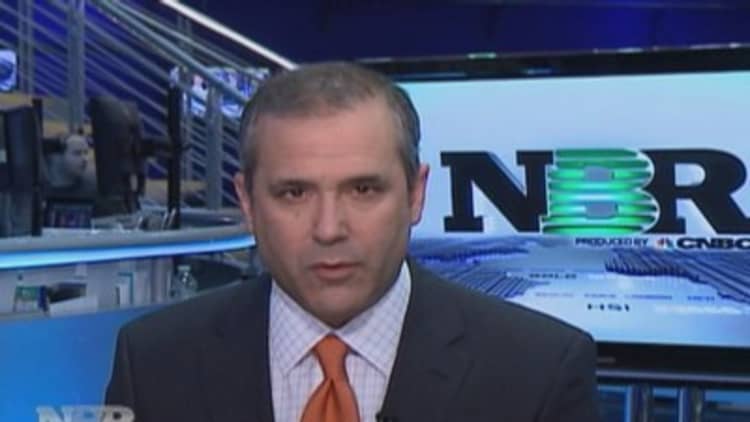The diagnosis: a serious case of medical gender gap.
Male doctors on average make 88 percent more in Medicare reimbursements than female physicians, according to an analysis of recently released government data, which suggests that the gender of a medical provider could play a role in the number of services they provide patients.
The NerdWallet research found that male physicians on average were paid $118,782 in Medicare reimbursements by the federal government in 2012, compared with $63,346 for women doctors.
The difference is particularly striking because Medicare—the government's health insurance program for people 65 and older—pays men and women doctors the same amount for the individual services they perform on patients in the same geographic area.
Read MoreWhat to watch for in biotech earnings
But the reasons for that very wide gap in total reimbursements included the fact that male doctors on average saw 60 percent more Medicare patients than their female counterparts, according to NerdWallet Health, a division of the NerdWallet price-comparison site. Men saw 512 patients on average, versus 319 for women.
However, another reason was the fact that male doctors on average perform more procedures or services on Medicare patients than female physicians, NerdWallet found. Among doctors who billed Medicare, men on average performed 5.7 services per patient, compared with 4.7 services by female doctors.
As a result, male doctors earn 24 percent more per patient from Medicare than female physicians—$262 per patient for male MDs versus $211 per patient for female MDs.
"What was interesting was, we saw this discrepancy across specialties," said Andrew Fitch, a lead researcher on the report.
Read MoreObamacare final enrollment hits 8 million
Fitch noted that the only specialty where there was no disparity between the number of services provided was among pathologists—doctors who check tissues for disease and the accuracy of lab tests.
He added that pathologists have "very little control" over the number of services they provide.
Fitch said the fact that male doctors perform more services for their Medicare patients than female physicians raises the possibility that gender "may play a role" in how doctors treat their patients.
"It is something that we should be looking at, as to why this variation exists," Fitch said. "It's worth trying to figure out if that plays a factor."

Dr. Fisayo Ositelu, a physician on the NerdWallet Health team, agreed.
"This certainly begs the question of whether men and women practice medicine differently," Ositelu said. "The bottom line is patients may experience higher costs through doctors who bill for more services per patient."
That possibility could have financial consequences for the nation because Medicare pays through a fee-for-service system in which "doctors have a financial incentive to provide more services."
Medicare is also the single largest payer of health insurance coverage in the US.
However, factors other than gender could be playing a role in the disparity of payments, according to NerdWallet.
Read More
The site notes that Medicare payments vary by geographic location, so if women doctors are concentrated in ZIP codes with lower reimbursement rates, that could skew their average downward. Another possibility is that male doctors on average may be performing procedures with higher reimbursement rates than their female counterparts.
A third possibility is the fact that the government, because of privacy concerns, has not released data in cases where fewer than 11 patients were treated by an individual doctor for a certain procedure. If women doctors are more likely than male physicians to have procedures or patient totals in that low-end range, their reimbursement average could be skewed as well.
NerdWallet's analysis was based on a massive set of data released April 9 by the federal Centers for Medicare and Medicaid Services, which contained information about $77 billion in Medicare reimbursements for information for 880,000 medical providers in 2012. It was the first time in 35 years that CMS had released such data about reimbursements to individual providers.
Medicare’s major payment “gender gap”
| Physician<br> specialty | Total physicians | Average medicare<br> payment (Women) | Average medicare<br> payment (Men) | Average patients<br> treated (Women) | Average patients<br> treated (Men) | Payment per<br> patient (Women) | Payment per<br> patient (Men) | Physician<br> specialty |
|---|---|---|---|---|---|---|---|---|
| Internal Medicine | 88,753 | $63,741 | $112,662 | 264 | 400 | $232 | $278 | Internal Medicine |
| Family Practice | 76,072 | $36,620 | $66,944 | 198 | 299 | $178 | $211 | Family Practice |
| Emergency Medicine | 36,237 | $48,372 | $62,110 | 391 | 494 | $122 | $124 | Emergency Medicine |
| Anesthesiology | 31,699 | $20,063 | $30,249 | 146 | 176 | $145 | $167 | Anesthesiology |
| Diagnostic Radiology | 27,926 | $97,753 | $125,849 | 1519 | 2046 | $84 | $86 | Diagnostic Radiology |
| Obstetrics/Gynecology | 22,789 | $11,324 | $15,653 | 94 | 106 | $96 | $115 | Obstetrics/Gynecology |
| Cardiology | 21,815 | $136,586 | $234,243 | 879 | 1146 | $188 | $235 | Cardiology |
| Psychiatry | 21,229 | $23,210 | $39,442 | 113 | 166 | $206 | $238 | Psychiatry |
Source: Source: NerdWallet
At the time of the release, CMS officials said they hoped the data would be analyzed by the media and by private researchers to help ferret out fraud and discrepancies that indicate unnecessary or excessive treatments being performed.
Read MoreObamacare helped 10 million uninsured, says Gallup
"We want the public's help, we want reporters' help to identify spending that appears to be wasteful," CMS principal deputy administrator Jonathan Blum said when the numbers were released. "We want the press and outside researchers to mine this data to find outliers, to identify spending that does not appear to be in the beneficiaries' interest and taxpayers' interest."
NerdWallet's Fitch called the Medicare data "a treasure trove."
"I think we'll be analyzing this data for a long time to come," he said.
—By CNBC's Dan Mangan.


